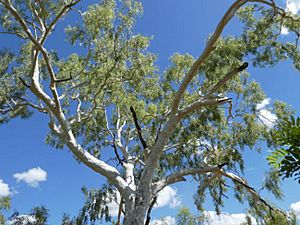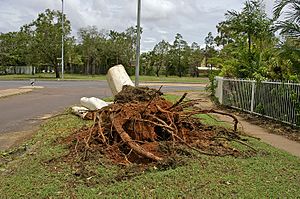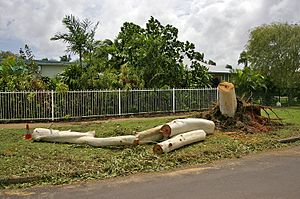Weeping ghost gum facts for kids
Quick facts for kids Ghost gum |
|
|---|---|
 |
|
| Corymbia bella in Katherine | |
| Scientific classification | |
| Genus: |
Corymbia
|
| Species: |
bella
|
| Synonyms | |
|
Eucalyptus bella Brooker |
|
The Ghost Gum (scientific name: Corymbia bella) is a beautiful tree found only in northern Australia. It's also known as the weeping ghost gum or paper-fruited bloodwood. This tree is famous for its smooth, white bark that looks like powder. It has long, narrow leaves, creamy white flowers, and unique cup-shaped fruits.
Contents
What Does the Ghost Gum Look Like?
The Ghost Gum usually grows to be about 6 to 20 meters (20 to 66 feet) tall. Sometimes, it can even reach 30 meters (98 feet)! It has a special woody swelling at its base called a lignotuber, which helps it regrow after fires.
Bark and Leaves
The bark of the Ghost Gum is very smooth and feels powdery. It's usually white or a light grey color. The tree sheds its bark in thin pieces, but sometimes a little bit of rough bark stays at the bottom.
Young Ghost Gum plants have dull green leaves that are shaped like an oval or a spear. These leaves are about 6.5 to 11 centimeters (2.6 to 4.3 inches) long. As the tree grows, its adult leaves become longer and narrower, like a spear or slightly curved. They are about 7 to 23 centimeters (2.8 to 9.1 inches) long and are the same green color on both sides.
Flowers and Fruit
The Ghost Gum's flowers are a lovely creamy white color. They usually bloom between September and January. The flower buds grow in groups of three. When they are ready to open, they look like small pears.
After the flowers, the tree produces woody fruits called capsules. These fruits are shaped like a cup, a barrel, or an urn. They are about 8 to 11 millimeters (0.3 to 0.4 inches) long. You can often see these fruits on the tree for most of the year.
Where Does the Ghost Gum Live?
The Ghost Gum tree is found across the northern parts of Australia. You can see it in the Kimberley area of Western Australia, all the way through the Northern Territory, and into northern Queensland.
Common Locations
It's very common in areas that have a monsoon season, which means they get a lot of rain at certain times of the year. You can find it as far west as Broome. It also grows along the Mitchell Plateau, near towns like Kununurra and Derby.
In the Northern Territory, it spreads from Top Springs to Pine Creek and up to Darwin. It also grows around the Gulf of Carpentaria. In Queensland, it's found from Doomadgee to Cloncurry and Croydon. You can also spot it in the southwest of the Cape York Peninsula.
Preferred Environment
The Ghost Gum loves to grow in rich, fertile soils found along low-lying areas that get wet during the rainy season. These include places like flood plains, where it's part of the woodlands. You'll also often see it along creek banks and at the edges of swamps and lakes, growing among Melaleuca trees. It's also part of the savanna woodlands in the lower parts of these plains.
How to Grow a Ghost Gum
It's quite easy to grow a Ghost Gum tree from its seeds! Even though it comes from warm northern Australia, it can grow well in colder places too.
Planting Tips
This tree can adapt to most types of soil, as long as the soil drains water well. It likes a sunny spot. The Ghost Gum is known for being tough and can handle dry conditions and even some frost.
In Australia, you can plant the seeds almost any time of the year. However, it's best to plant them in spring or autumn if you live in a place with a milder climate. The best temperature for the seeds to sprout is around 18 to 22 degrees Celsius (64 to 72 degrees Fahrenheit).



